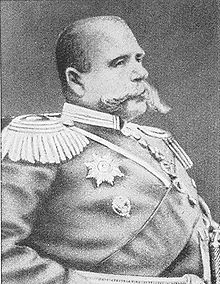Paul von Rennenkampf - Picture
More about World War 1

|
|
Paul von Rennenkampf
Place of birth: Konuvere, Governorate of Estonia, Russian Empire
Place of death: Taganrog, Russian Empire
Allegiance: Russian Empire
Service/branch: Imperial Russian Army
Years of service: 1873-1915
Rank: General
Commands held: Russian First Army (1914)
Battles/wars: World War I
Paul von Rennenkampf (or Pavel Karlovich Rennenkampf) (Russian: Ðавел ÐаÑÐ»Ð¾Ð²Ð¸Ñ Ñон РенненкампÑ) (April 17, - 1 April 1918) was a Russian general who served in the Imperial Russian Army for over 40 years, including during World War I.
Biography
Rennenkampf was of Baltic German extraction, and was born in 1854 in Konuvere Mansion, now in Mx¤rjamaa Parish, Rapla County, Estonia. He joined the Imperial Russian Army at 19 and attended the Junker Infantry School in Helsinki. He began his military career with the Lithuanian 5th Lancers Regiment. He graduated at the head of his class from the Nikolaevsky Military Academy in St. Petersburg in 1882. He was assigned as a junior officer to the 14th Army Corps until 1884, and to the Warsaw Military District followed by the Kazan Military District to 1886. Rennenkampf subsequently was a senior aide to the headquarters of the Don Cossaks from March 1888, staff officier to the 2nd Army Corps from October 1889, and Chief of Staff of Osowiec Fortress from March 1890. The same year he was promoted to colonel. From November 1899, Rennenkampf as chief of staff of the Transbaikalia region and was promoted to major general.
Rennenkampf commanded four infantry battalions, two Cossack sotnias, and two horse batteries, during the Boxer Rebellion in 1900-01, and was responsible for the capture of Tsitsihar and Kirin in Manchuria, thereby removing any Boxer threat to Harbin and the Chinese Eastern Railway. During this campaign, he was decorated with the both the 4th degree and 3rd degree Order of St. George for military distinction.

Picture - Paul von Rennenkampf, Russian general, 1854-1918, commander of the 1st Russian Army during 1914.
After the rebellion, Rennenkampf was offered a command in the Imperial Guard, but to the Tsar's surprise, he turned down the command. He was then given command of the 1st Independent Cavalry Brigade, a command he held until 1904.
In February 1904, after the outbreak of the Russo-Japanese War, Rennenkampf was appointed commander of the Trans-Baikal Cossack Division. He was promoted to lieutenant general in July 1904, and was wounded in the same month, remaining hospitalized until after the Battle of Liaoyang. He actively commanded a division-size force during the Battle of Shaho, and a corps sized force during the Battle of Mukden. At Mukden, he replaced Major General Mikhail Alekseyev in command of the Russian left flank after a series of defeats and managed to stabilize the situation. However, after the Battle of Mukden, General Alexander Samsonov accused Rennenkampf of failing to assist him during the fighting, and the two came to blows. After the Russo-Japanese War, Rennenkampf restored part of his reputation dealing with revolutionaries in Siberia. His harsh suppression of Chita Republic led to his promotion to full general in December 1910. From 1912, he was promoted to Adjutant General appointed Chief-of-Staff of the Vilno Military District.
At the start of World War I, Rennenkampf was given command of the Russian First Army for the invasion of East Prussia, advancing from the North East. His behavior during the Battle of Tannenberg, particularly his failure to coordinate with Samsonov's Second Army, resulted in much criticism from sector commander General Yakov Zhilinskiy and attempts by some members of the military high command to have him removed from command.
After relative success at the Battle of Gumbinnen in mid-August, failure at the First Battle of the Masurian Lakes that same month, which forced a Russian withdrawal from East Prussia, and at the Battle of Åx³dź in November 1914 led to Rennenkampf's dismissal amid recriminations of incompetence and even treason (due to his heritage). Rennenkampf gave his resignation on October 6, 1915. After the February Revolution of 1917 he was imprisoned in the Peter and Paul Fortress in St. Petersburg by the Russian Provisional Government and accused Rennenkampf of criminal activities from the start of World War I, including embezzlement and mismanagement.
Rennenkampf was set free after October Revolution and moved to the city of Taganrog on Azov Sea coast, where he lived under the false name of Mandusakis claiming to be a Greek citizen; however, the ruse was discovered by the Bolsheviks on March 16, 1918. The Bolsheviks approached him and offered a command in the Red Army to serve during the Russian Civil War. He refused the offer and was promptly arrested and executed on 1 April 1918 on the personal orders of Vladimir Antonov-Ovseyenko.
Rennenkampf's personal belongings and art objects that he acquired during the Boxer Rebellion are now displayed in the Alferaki Palace in Taganrog.
Honors
Order of St. George, 4th class,
Order of St. George, 3rd class,
Order of St. Stanislaus 3rd degree
Order of St. Anne 3rd degree
Order of St. Stanislaus 2nd degree
Order of St. Anne 2nd degree
Order of St Vladimir, 4th degree
Order of St Vladimir, 3rd degree
Order of St. Stanislaus 1st degree with swords
Golden Sword of St. George, with diamonds, 1906
Connaughton, R.M (1988). The War of the Rising Sun and the Tumbling Bear-A Military History of the Russo-Japanese War 1904-5, London, ISBN 0-415-00906-5.
Jukes, Geoffry. The Russo-Japanese War 1904-1905. Osprey Essential Histories. (2002). ISBN 978-1-84176-446-7.
Warner, Denis & Peggy. The Tide at Sunrise, A History of the Russo-Japanese War 1904-1905. (1975). ISBN 0-7146-5256-3.
More aircraft.
Source: WikiPedia